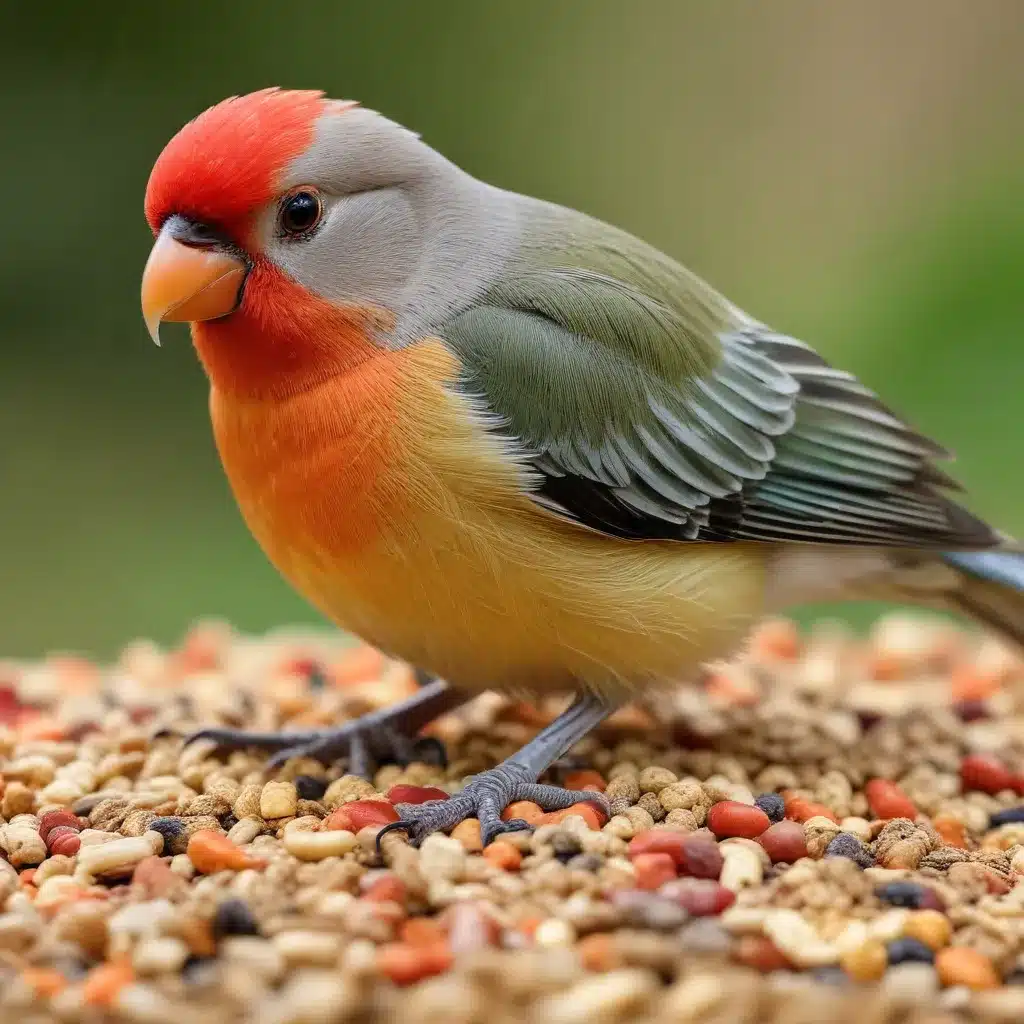
Avian Nutrition
As an experienced avian caretaker, I know that providing a nutritious diet is one of the most important aspects of caring for our feathered friends. Ensuring your birds receive an optimal balance of vitamins, minerals, antioxidants, and other essential micronutrients is crucial for their overall health and wellbeing.
Micronutrient Composition
At the foundation of any healthy avian diet are the essential vitamins and minerals required to support basic physiological functions. Vitamins A, D, E, and the B-complex play pivotal roles in vision, bone development, immune function, and energy metabolism. Key minerals like calcium, phosphorus, magnesium, iron, and zinc are equally vital for skeletal integrity, red blood cell production, and enzymatic processes.
But the nutritional needs of birds extend far beyond these basic vitamins and minerals. Phytochemicals and antioxidants found in plant-based foods can provide powerful protective benefits. Carotenoids, for example, not only give many birds their vibrant plumage coloration, but also act as free radical scavengers to mitigate oxidative stress. Flavonoids, polyphenols, and glucosinolates have been shown to support immune function, detoxification, and overall cellular health in avian species.
Nutrient Density Evaluation
Evaluating the nutrient density of potential bird foods is crucial for optimizing your feathered companions’ diets. One established method is the Aggregate Nutrient Density Index (ANDI), which scores foods on a scale of 1 to 1000 based on their concentrations of essential vitamins, minerals, phytochemicals, and antioxidant capacity.
Foods scoring highest on the ANDI scale – such as kale, swiss chard, collard greens, and watercress – provide the most “bang for your buck” in terms of micronutrient content per calorie. However, other factors like bioavailability, anti-nutrient compounds, and species-specific preferences can also impact a food’s true nutritional value for birds.
Avian Diet Considerations
Species-Specific Feeding Habits
The optimal diet for your birds will depend heavily on their natural feeding behaviors and evolutionary adaptations. Granivorous birds like parrots, cockatiels, and finches tend to thrive on a varied mix of high-quality seeds, grains, nuts, and produce. In contrast, insectivorous species such as canaries, tanagers, and hummingbirds require a greater proportion of protein-rich invertebrate prey and nectar-rich flowers to meet their unique nutritional needs.
Nutritional Requirements
Beyond species-specific considerations, the precise micronutrient requirements of your birds will also vary based on their life stage, activity level, and overall health status. Younger, growing birds often need higher concentrations of calcium, phosphorus, and amino acids to support skeletal development and tissue synthesis. Breeding and molting birds may have heightened demands for vitamins A, B12, and D, as well as carotenoids, to fuel feather growth and reproduction.
Bird Food Selection
Evaluating Bird Food Options
When it comes to selecting appropriate foods for your avian companions, whole, minimally-processed ingredients should always be the priority over highly refined, commercial bird feeds. Opt for organic, sustainably-sourced produce, grains, legumes, nuts, and seeds whenever possible to maximize nutrient density and minimize exposure to harmful pesticides or contaminants.
That said, a carefully formulated, nutritionally-complete pelleted or extruded diet can provide a useful foundation, especially for insectivorous or picky eaters. Just be sure to supplement with a diversity of fresh, whole foods to round out the nutritional profile.
Optimizing Nutrient Intake
To truly optimize the micronutrient density of your birds’ diet, variety is key. Rotate through a wide selection of dark leafy greens, vibrant fruits and vegetables, whole grains, and lean protein sources to ensure they receive a comprehensive array of essential vitamins, minerals, and phytonutrients.
Targeted supplementation with high-quality avian vitamins, minerals, and antioxidant blends can also help fill any nutritional gaps, especially for birds with special needs or dietary restrictions. Just be sure to follow dosage guidelines carefully and avoid over-supplementation, which can lead to imbalances.
Foraging Behavior and Ecology
Natural Feeding Patterns
In the wild, birds rely on their innate foraging behaviors and keen senses to seek out the most nutrient-dense foods available within their natural habitats. Ground-foraging species may focus on seeds, insects, and fallen fruits, while aerial insectivores adeptly capture flying prey. Nectar-feeding hummingbirds use their long, slender bills to extract the sweetest nectars from flowering plants.
Observing and understanding these natural feeding patterns can provide valuable insights for replicating an optimal, species-appropriate diet in the captive setting. Providing opportunities for natural foraging behaviors, such as scattered seeds or hidden treats, can also enrich the lives of our feathered friends.
Environmental Influences
The nutrient composition of foods available to wild birds can also fluctuate dramatically based on seasonal changes, weather patterns, and habitat characteristics. Leafy greens and fruits may be most abundant during the spring and summer growing season, while winter diets may shift more toward energy-dense seeds, nuts, and berries. Likewise, birds living in arid regions may have different nutritional needs than their counterparts in lush, tropical environments.
Carefully monitoring the seasonal availability and nutrient profiles of your local produce can help you better mimic these natural cycles in your avian companions’ captive diets. Rotating through a variety of regionally-appropriate, in-season foods can ensure they receive a diverse array of essential micronutrients throughout the year.
By taking a holistic, species-appropriate approach to avian nutrition, we can help our feathered friends thrive and maintain optimal health. Through a combination of nutrient-dense whole foods, targeted supplementation, and an understanding of natural foraging behaviors, we can maximize the micronutrient density of our birds’ diets for long-term wellbeing. For more information on feeding your birds a nutritious, balanced diet, be sure to visit the Mika Birds Farm blog.


